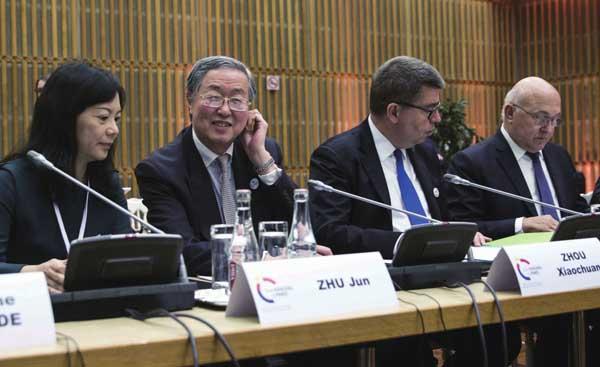Boosting the SDR
2016-05-14BySunJie
By Sun Jie

Before Chinas currency, the renminbi, officially joined the IMFs Special Drawing Rights (SDR) basket of currencies on October 1, SDR-denominated bonds issued by the World Bank (International Bank for Reconstruction and Development) had already made inroads in the Chinese interbank market with the approval of the Peoples Bank of China (PBOC), the central bank. The size of the issuance on August 31, the first of its kind, was 2 billion SDRs (approximately equivalent to $2.8 billion), and the bonds are payable in renminbi.
Since April, the PBOC has also started releasing its monthly foreign exchange reserve data denominated in SDR in addition to the U.S. dollar.
A series of actions taken by China, after the IMFs approval of the renminbi as a reserve currency last December, indicate that the worlds second largest economy is honoring its commitment to advancing the reform of the existing international monetary system.
Back in March 2009, PBOC Governor Zhou Xiaochuan called for the creation of an international reserve currency with a stable value, rule-based issuance and manageable supply, so as to achieve the objective of safeguarding global economic and financial stability.
More widely used
Since its foundation in 1969, the SDR has been closely connected with the international monetary system. The international economic environment has kept changing over the past 50 years, but the SDRs function as a tool for improving the international monetary system has been unchanged.
However, finding an effective method to fulfill the role which the SDR is expected to play in advancing international monetary reform remains a challenge. Thus, the issuance of SDR-denominated bonds in China is a significant step toward achieving goal.
SDR was designed as an international reserve asset to supplement IMF members reserve holdings in the context of the Breton Woods fixed exchange rate system. Therefore, it is only an artificial currency that isnt circulated in the market, nor does it represent a claim on the IMF. In fact, the IMF has never regarded itself as the worlds central bank issuing a world currency. In terms of playing the role of an international currency, the SDR only has the functions of standard of value, store of value and unit of account. But the lack of SDR-denominated assets has limited the artificial currencys store-of-value function. The SDR is used only to repay IMF debts and make up for international payment deficits among IMF members.
Although the SDR doesnt perform the basic function of an international currency as a medium of circulation or payment, it has become increasingly important because of the market risks intensified by floating exchange rate regimes, adopted after the collapse of the Breton Woods System. However, in the early 1980s, the U.S. dollar again became a safe asset, which weakened the SDRs risk-hedging function.
Since the 2008 global financial crisis, the U.S. Federal Reserve has given more consideration to the domestic role of the dollar when determining monetary policies. This gave little cause for criticism, but undermined the stability of the international monetary system. It has become a global consensus that the green backs importance as an international currency must be lowered.
In 2009, the IMF carried out its third, and largest, allocation of 182.6 billion SDRs to its member countries in proportion to their quotas in the organization. The total SDR holdings of IMF members have reached 204.1 billion (equivalent to about $285 billion), yet there is still no effective method for enhancing the role of the SDR in reforming the international monetary system.
New opportunities
Since the euro replaced the Deutsche mark and French franc in 2000, the currencies in the SDR basket had not subsequently changed, until the recent addition of the renminbi. This suggests that the system was unable to reflect changes in the international economic structure and in the use of world currencies. This is mirrored by the fact that the IMF started considering the inclusion of the Chinese currency into the SDR basket in 2010, while conducting its quinquennial review of the baskets composition.
As for China, the addition of the renminbi to the SDR currency basket enables it to better perform its responsibilities in maintaining global financial stability, and facilitate the further opening up of Chinas financial market. The IMF itself will also benefit from the move.
Besides acting as an international reserve asset, the SDR is used as a unit of account of the IMF. For instance, IMF loans are denominated in the SDR. As a result, recipient countries will hold debts corresponding to the weights of different currencies in the SDR basket.
According to IMF figures, central banks of 38 countries and regions throughout the world hold renminbi assets, totaling 780 billion yuan($116.94 billion) and accounting for 1.1 percent of global foreign exchange reserves.
China has made various efforts to make its foreign exchange regime more market-oriented and ensure reasonable yields on renminbi assets. The PBOC has improved the formation of the renminbis central parity rate against the U.S. dollar and further liberalized interest rates. The Ministry of Finance has also begun to issue short-term treasury bonds of three-month maturity. These reforms have helped Chinas foreign exchange and interest rate regimes become more efficient, transparent, consistent and fair. A market-determined exchange rate has created favorable conditions for SDR operations after the renminbi was included in the currency basket.
On April 7, the PBOC released foreign exchange reserve data denominated in the SDR, in addition to the U.S. dollar, for the first time. The PBOC is the first to do so among the central banks of the worlds major economies.
The currency value of the SDR is de-termined by summing the values in U.S. dollars—based on market exchange rates—of basket currencies, made up of the U.S. dollar, euro, yuan, Japanese yen and pound sterling. Therefore, the SDR exchange rate is more stable than any single currency. “Using the SDR as a reporting currency for foreign exchange reserve data would help reduce valuation changes caused by frequent and volatile fluctuations in major currencies, therefore it would provide a more objective measurement of the overall reserve value,”said a PBOC statement.
The SDR is not a currency, but as it is used in foreign exchange data, the market has become more familiar with it, which has created the appropriate conditions for issuing SDRdenominated bonds.
Facilitating reform
The World Banks first ever renminbi-settled, SDR-denominated bonds were backed by the Chinese Government. For the international community, this is an important attempt to make the SDR more market-oriented, expand its usage, and ultimately enhance the stability of the international monetary system. For China,“SDR-denominated bonds prove advantageous as a hedge against the interest rate and exchange rate risks stemming from financial instruments denominated in a single currency. The SDR-denominated bonds add a new product category to Chinas bond market, which will diversify the portfolios of domestic and international investors. The issuance will also help broaden the use of the SDR,” said the PBOC statement.
In addition to the advantages brought to investors through diversification, the approval of SDR-denominated bonds issuance in China demonstrates the Chinese Governments commitment to promoting the reform of the international monetary system.
The SDR has the potential to contribute to a more stable and resilient international monetary system, said PBOC Governor Zhou at the HighLevel Seminar on the International Financial Architecture held in Paris, France, on March 31. Zhou called for efforts to gradually broaden the use of the SDR, including using it as a reporting currency in parallel with the U.S. dollar and exploring issuance of SDR-denominated assets.
As the opening up of Chinas financial sector deepens, the international community has accepted the yuans status as an international reserve currency through its SDR inclusion. Therefore, China has gained new opportunities to promote the use of the SDR, which will help improve the current international monetary system.
Some media outlets argued that the Chinese Government had two objectives when giving the green light to the issuance of SDRdenominated bonds in the domestic market—promoting the international use of the renminbi and curbing capital flight. However, facts have proved that the renminbis internationalization is a market-driven process, while government policies only play a limited role. A more immediate impact of issuing SDR-denominated bonds in China will be the rise in market share and influence of SDR-denominated assets. Moreover, the PBOC has rich experience and many available tools, other than SDR-denominated bonds, to address capital outflows.
The issuance of SDR-denominated bonds will be certain to diversify the product categories in Chinas bond market and promote its openness and development, but the real target of Chinas central bank is indeed to advance the reform of the international monetary system and demonstrate Chinas status as a responsible big country.
